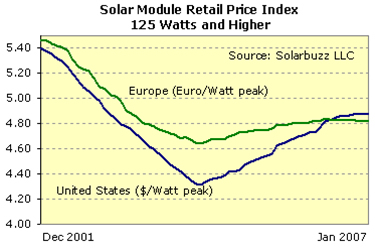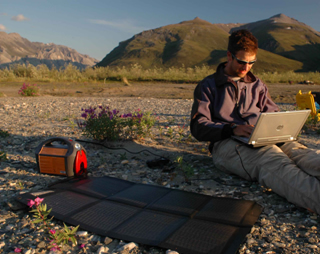Copper-based Solar Cells:
Good for the Environment, Good for the Consumer
Copper Applications in Electrical Area
Lower-cost, More Efficient Manufacturing Brings Down the Cost of Solar Installations
The hottest buzz-word in energy circles these days has got to be "renewables," which refers, of course, to energy sources that can be regenerated, like biofuels, as well as physical sources, like wind, hydro, geothermal and solar, which cannot be depleted. Using renewables in place of carbon-based fuels offers obvious environmental and perhaps geopolitical advantages, although most alternative energy sources still generally require subsidies or incentives to remain viable. In the case of solar electrical generation, the economic situation has, in fact, temporarily gotten worse, as we shall explain.
Copper and its alloys have been a part of renewable and other "green" energy systems for many years. Examples include the copper tubing found in highly efficient, direct-exchange geothermal heat pumps and the massive amounts of copper cables employed in the harnessing of wind energy.
Less well known is the role that copper is and will be playing in solar-based electrical power production. Copper has long been used in solar heating/hot water systems, where it is commonly used in heat exchangers. Now, it promises to become equally valuable in photovoltaic (PV) systems. These systems produce electricity through the action of sunshine on certain semiconductors, including mono-, polycrystalline and amorphous silicon and so-called thin-film materials like cadmium telluride, gallium arsenide, and the currently most promising material (and the one with the longest name): copper-indium-gallium-diselenide, Cu(InGa)Se2, or CIGS (Figure 1).
 Figure 1. Relatively low manufacturing costs for thin-film copper-indium-gallium-selenium (CIGS) solar cells such as those shown here hold out the promise of cheap, "green" electric power (Photo courtesy Global Solar, Inc.).
Figure 1. Relatively low manufacturing costs for thin-film copper-indium-gallium-selenium (CIGS) solar cells such as those shown here hold out the promise of cheap, "green" electric power (Photo courtesy Global Solar, Inc.).The intermetallic compound Cu(InGa)Se2, or copper (indium-gallium) diselenide, commonly called CIGS, is a semiconductor. It differs from silicon, the most common semiconductor used in photovoltaic cells, in that it is a member of a class of so-called heterojunction semiconductors. In these materials, semiconducting properties arise from an atomic-scale layered structure in which alternating bands, having different compositions from their neighbors, exhibit different energy band gaps. The structure, as found in CIGS, resembles that of the common copper ore mineral, chalcopyrite, CuFeS2. A carefully prepared CIGS cell currently holds the record for solar energy conversion (19.5%) in a non-concentrated cell.
But with today's explosive growth in solar power, why are the costs of PV power suddenly rising after many years of decline? The answer has to do with silicon, which has been the workhorse of PV devices for years and which continues to account for almost all large installations today. Rapid growth in the number of solar power facilities has recently (2004-2007) led to shortages of cell-grade silicon, and prices have risen accordingly. Sharply higher energy costs also helped drive prices higher, since the production of pure silicon feedstock is highly energy-intensive (Figure 2).
 Figure 2. Rapidly growing demand for solar installations have led to shortages of silicon, which, combined with high energy costs, have led to increases in the price of solar modules. Copper-based CIGS modules offer more efficient, lower-cost manufacturing, which should eventually lead to a resumption of the historic (downward) price trend.
Figure 2. Rapidly growing demand for solar installations have led to shortages of silicon, which, combined with high energy costs, have led to increases in the price of solar modules. Copper-based CIGS modules offer more efficient, lower-cost manufacturing, which should eventually lead to a resumption of the historic (downward) price trend.This is where CIGS offers an important advantage. Its manufacturing process, while certainly complex, is relatively energy-efficient compared with that for silicon. For example, with CIGS there is no need to melt, cast and finally slice the semiconductor into thin wafers, as is done with some forms of silicon. And, CIGS manufacturing processes have advanced to the point where the material is now routinely produced semi-continuously as a "coating" on long strips of suitable substrates. As a result, the cost of CIGS modules has steadily decreased and is now reportedly lower than polycrystalline silicon, the most common solar cell semiconductor, (Table 1).
| Module Type | Lowest Module Price, US$/Watt, peak |
|---|---|
| Monocrystalline Silicon | 4.36 |
| Polycrystalline Silicon | 3.88 |
| Thin-Film (CIGS and others) | 3.79 |
Scott Albright, Director of Advance Programs for Tucson, Arizona-based Global Solar, flatly states that CIGS is now cost-competitive with silicon. "And," he adds, "unit costs will continue to decrease as we begin to take advantage of economies of scale." He's referring to the fact that Global Solar is currently expanding into a 100,000-sq ft facility, a move that will increase the company's output from four megawatts per year (MW/y) to more than 40 MW/y in 2008. The company is also expanding its manufacturing operations in Germany. Once a part of the group that includes Tucson Electric Power (TEP), the local utility, the 11-year-old firm is now owned by solar module manufacturer Solon AG and a private German investor.
Why Germany?
Why would German investors be interested in an American PV producer when they have plenty of manufacturing capacity of their own? The reason might lie in the fact that Germany currently leads the world in solar energy utilization. Latest available statistics (Data from Solarbuzz.com, a solar energy industry tracking organization) indicate that of the 1,460 MW of installations made throughout the world in 2005 (which set a historic record), Germany accounted for 837 MW, or 57% of the total. Japan was second, at 292 MW (20%). The USA, which led the world in solar product shipments until the mid 1990s, installed only 80 MW (7%) in 2005. According to one industry analyst, the US now lags because state and federal governments offer fewer demand-side subsidies than their foreign counterparts; there are also fewer incentives for manufacturers, and we have higher manufacturing costs. An additional factor is the relatively low cost of conventionally produced electric power enjoyed by most U.S. residents and industries.
As is true for other companies now entering the solar market, many of Global Solar's early years were devoted to product and process R&D. The company's earlier TEP connection was fruitful at the time, since it complemented the utility's very large solar farm in Springerville, Arizona, Figure 3. The 4.6-MW Springerville farm (that's its 2007 capacity, which may be increased) contains 34,980 silicon-based modules. There aren't a significant number of CIGS modules in the array since, at the time, Global Solar was engaged in the development of flexible CIGS modules, which aren't intended for fixed installations like Springerville.
 Figure 3. Tucson Electric Power's 4.6-MW Springerville Solar Farm in Arizona, one of the largest solar installations in the world. Output from the facility's 34,980 modules (as of 2006) powers well pumps for an adjacent conventional generating station (Photo courtesy Tucson Electric Power).
Figure 3. Tucson Electric Power's 4.6-MW Springerville Solar Farm in Arizona, one of the largest solar installations in the world. Output from the facility's 34,980 modules (as of 2006) powers well pumps for an adjacent conventional generating station (Photo courtesy Tucson Electric Power).Acording to industry news service SolarForecast.com, a number of companies are currently producing or ramping up to produce CIGS (see Who Makes CIGS below), but by any measure, Global Solar is a leader in CIGS production technology. Breaking new ground early-on, the company's engineers developed an efficient roll-to-roll film deposition process onto stainless steel that has since been reduced to commercial practice. As it was intended to do, the process enables lower manufacturing costs and higher product yields than do the batch operations used in traditional semiconductor manufacture. Improvements continue as the company gains know-how. Mean electrical efficiency of the company's CIGS modules has risen, and product uniformity is tightening nicely.
Have Module, Will Travel
In fact, Global Solar's early R&D was so successful that the company is now the world's leading flexible PV supplier. Global's light, flexible (and therefore easily portable) modules were first adopted by U.S. and foreign armed forces, who requested a reliable power source for the many battery-driven electronic widgets today's high-tech warriors carry (Figure 4). Global has also brought a number of innovative consumer products to market. Those devices are mostly used by sportsmen and outdoors enthusiasts (Figure 5), although some find their way to rather exotic locales (Figure 6).
 Figure 4. Global Solar's foldable, flexible CIGS modules provide portable electric power for U.S. Army personnel. The two side-by-side P3-55 modules shown here each produce 55 W, yet weigh less than four pounds apiece (Photo courtesy of Global Solar Inc.).
Figure 4. Global Solar's foldable, flexible CIGS modules provide portable electric power for U.S. Army personnel. The two side-by-side P3-55 modules shown here each produce 55 W, yet weigh less than four pounds apiece (Photo courtesy of Global Solar Inc.). Figure 5. Civilian uses for lightweight, flexible CIGS solar modules include battery charging and portable power for PDAs, cell phones and laptop computers (Photo courtesy of Global Solar Inc.).
Figure 5. Civilian uses for lightweight, flexible CIGS solar modules include battery charging and portable power for PDAs, cell phones and laptop computers (Photo courtesy of Global Solar Inc.). Figure 6. This is not a staged picture! A scientist working in Antarctica needed an environmentally nonintrusive power source to recharge his PDA and lalptop batteries. One of Global Solar's portable CIGS modules provided the "green" solution (Photo courtesy Global Solar Inc.).
Figure 6. This is not a staged picture! A scientist working in Antarctica needed an environmentally nonintrusive power source to recharge his PDA and lalptop batteries. One of Global Solar's portable CIGS modules provided the "green" solution (Photo courtesy Global Solar Inc.).But consumer appliances are only a part of Global Solar's plans. The company has completed development of a series of rigid, panel-mounted modules that will be suitable for a solar farm like Springerville, and can be used, as well, for those increasingly familiar rooftop installations. "Utilities see solar farms as a way to gain distributed power sources," says Albright. "Solar farms of appropriate sizes might be situated along major transmission lines to make up for losses, or they can be built near large, remote loads. That technology is coming, and that's where we believe a really significant amount of solar utilization will develop."
So Where's All the Copper?
The CIGS material in a solar cell is only a few microns thick, and the copper in it makes up only a fraction of its weight. Scott Albright calculates that his company's modules contain only about one-half gram of copper per square foot of cell surface area, which would come to a measly two metric tons of copper in all of Global's planned 40-MW annual capacity. That's about as much copper as you'd find in 80 automobiles.
However, the power generated by individual solar modules ― like the nearly 40,000 modules already in place at Springerville ― has to be transmitted somewhere else in order to be useful. When distributed solar power attains the scale Scott Albright envisions, it could bring with it the need for miles of copper cables, not to mention copper-loaded transformers, inverters and switchgear.
And that's just for the power equipment. Section 690 (V) of the National Electrical Code, (NEC), mandates that solar installations must be grounded. If experience with wind farms (which also have stringent grounding requirements) is any indication, the amount of copper used for grounding cables in large solar farms could become significant. And rightly so, since only copper cables and connectors provide the reliability that these systems demand.
If Scott Albright is correct in his belief that solar energy's time has come ― and an industry that's expanding globally at a 34% compounded annual growth rate can't be ignored! ― then the environment, and copper, have a bright future indeed.
Who Makes CIGS?
Industry news service SolarForecast.com recently (2007) listed companies that are currently producing CIGS photovoltaics or are planning to do so by 2008. In view of the ongoing shortage of silicon and growing investor interest in solar energy in general, it would be reasonable to expect this list to expand in the future.
aleo solar AG, Germany
DayStar Technologies, US
Global Solar, Inc, US
Honda Motor Company, Japan
MiaSole, US
Nanosolar, Inc, US
Shell Solar, Germany, US
Showa Shell Sekikyu, Japan
Würth GmbH, Germany
Also in this Issue:
- Copper-based Solar Cells:
Good for the Environment, Good for the Consumer
